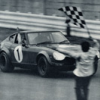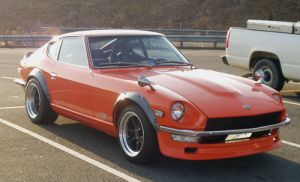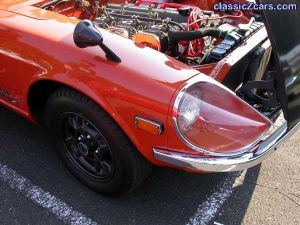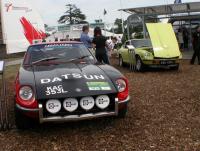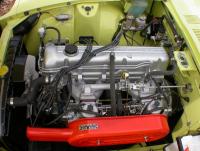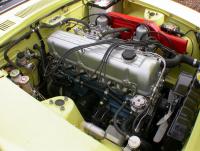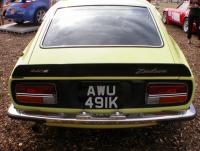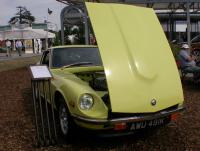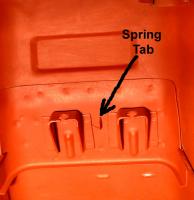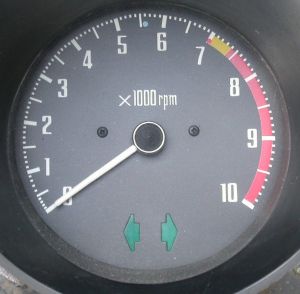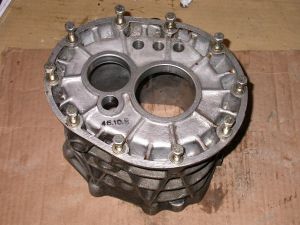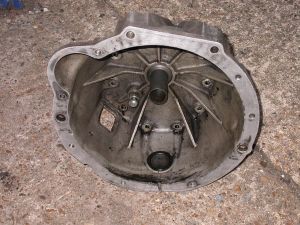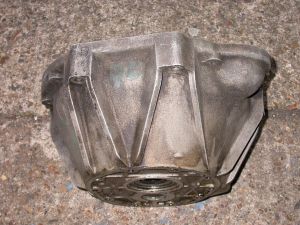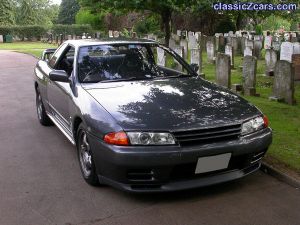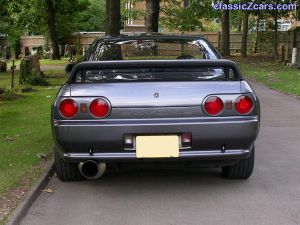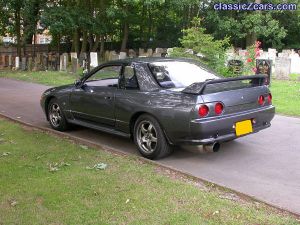Everything posted by HS30-H
-
Fairlady Z (replica)
The caption reads "Fairlady Z" - so that's why I pointed out that it must be a replica. However, the only things I can see from the photo that are arguably 'Fairlady' specific are the mirrors and the Overfenders. Nice car!
-
Reproduction JDM headlight covers with trim
Hi Ben, I'm having new plastic parts made for the three used sets that I have, but I'm not planning on making any of the surrounds. I don't think its as easy as it looks. Additionally, I have lent a pair of NOS covers to a Z resto specialist company here in England. This was in order for them to investigate the possibilities of tooling up for the manufacture of exact replicas, but its taking some time........ What I can say is that its not as easy as it might at first seem. These are complicated shapes to bend a u-shaped channel into without puckering and stretching the corners. Nissan's original supplier didn't do such a great job themselves ( although I love them ) and stress fractures are not uncommon. The earliest of these covers were a Chrome finish, but later covers were made from Stainless. Sometimes its necessary to 'tweak' them a little when fitting for the first time, and this can sometimes cause cracks in the butt weld that joins the two ends of the channel together - especially on the stainless versions. The plastic tends to crack from the fixing holes to the outside edge as it gets older and more brittle, especially in extremes of heat and cold ( and when you go very very very fast ). The original fixings are hilariously crap too. That can be rectified with better mounting hardware that will not be seen once they are fitted ( 'Rivnuts' for example ), but I have no idea how any 'improvement' to the misting / dirt build-up problems can be made without changing the look of the things. Alan T.
-
Fairlady Z (replica)
-
are gs31 and s30 body pannels swappable
The Japanese market cars changed from the 'S30' model code to 'S31' in late 1975. All the 'S31' cars used the injected L20E engine, but previous domestic models used the L20, L24 and S20 engines. There was a brief period in Japan where RS30 ( L26 engined ) models were being made for domestic sale, but after problems with them the Factory converted these cars to L20 engines and restamped the VINs accordingly. rusty260z, That 'G' prefix on your car denotes a 2+2, and the fact that its a a 'GS31' shows that it is a Japanese home market 'Fairlady 2/2' model. I think you know that already. Most of the panels are interchangeable on a like-for-like basis ( S30 / S31 2 seater for S30 / S31 2 seater and S30 / S31 2+2 or 2/2 for S30 / S31 2+2 or 2/2 ). Of course, 2 seater-specific panels will not fit a 2+2 / 2/2 and vice-versa. That's all you need to look out for really. What panels specifically? Maybe we can help in more detail if we have more info.
-
Sagamiko-80
No mistake......... The carbs are on the correct side for this engine. Its an S20 twin cam in a genuine Fairlady 432R. So, yes - it is a 'crossflow' design, but not an 'LY' Crossflow. Other pics of this car are in my gallery.
-
Just bought a factory restored 72 240Z!
Hi Ben, Mr Duncan Pearcey of The Z Farm built both cars ( and drives the rally car himself too ). As far as I understand it, Nissan UK paid for the restoration of the car and sourced some of the parts from the USA and Japan. Duncan also supplied some NOS and good used parts from his own stock. I'm very interested to hear what people think of this car, and indeed what it can be classified as ( seeing as Nissan UK commissioned the job ). Another pic from the Nissan stand at Goodwood for you:
-
Just bought a factory restored 72 240Z!
Hi Ben, Thanks for your support on this point. It seems like pointless nitpicking to some, I know - but people have already misunderstood the situation and ( as I mentioned before ) some journalists in the past have already written that the cars were sent back to Japan! If nobody stands up for clarification of the facts then its the start of the slippery slope. This is how myth becomes legend. Thanks too for confirming that some Americans at least will have heard of Bristol Cars Ltd ( and not just their engines ). I'm still waiting for 26th-Z to tell me why Bristol don't count as an example of auto manufacturers who have bought back, restored and re-sold their own product........... My thanks to Vicky for quoting NMC USA's description of the "Nissan Vintage Z Pre-Owned Vehicle" program. Its especially good to hear this from an owner of one of these cars. I'll try to remember and use that description for these cars in future. Ben, Yes indeed, the car in the photo is the very one that has been loaned to journalists here in the UK for magazine articles, and has been used on Nissan UK's show stands at several events. Its on the cover of the Sept. edition of Practical Classics magazine. The journalist quotes the designer as Goertz again...... More pics of the car:
-
Just bought a factory restored 72 240Z!
gruvyz, What's wrong with discussing this subject "deep & long"? If you are going to be a regular participant, then you will - hopefully - start to understand that deep & long discussions, by people with "WAY too much time" on their hands, are the lifeblood of a forum like this. When people cannot be bothered to reply, or even be bothered to post in the first place, is when you should worry............ You asked: "....who REALLY cares about the inference to whether or not they were actually done in Nissan's factory!" Well, as you can probably tell from my posts - I care. If you are going to throw the word 'Factory' around freely then you really ought to think deep & long about what it means, and what you are inferring by using it in connection with your car. Your car was restored by an American specialist restoration company on behalf of NMC USA. That's a quite different thing to being restored "by the original manufacturer". I like to ask your opinion on a related subject; A couple of years ago, Nissan UK decided that they would like to have a good example of a UK-market HS30 "240Z" of their own - to use as a promotional tool. They looked around in the UK for a car to buy, and contracted the services of a Z specialist here to undertake the restoration for them. They supplied the funding and sourced some of the parts for the project. Now, other than the fact that this car was never destined to be sold to the general public, and was not part of a 'program' or well publicised advertising project, how is it any different to your car? Are you going to call this car a "Factory Restored" car too? I'm very eager to hear your answer, and any comments from anybody else.............. I attach a photo of the car in question. It was taken on the Nissan UK stand at the Goodwood Festival of Speed. I applaud your intention to use your car and enjoy it. Alan T.
-
Just bought a factory restored 72 240Z!
WHY NOT? I repeat - Bristol Cars Ltd have been buying back cars from customers and the used car trade, completely restoring them in their own factory, and then selling them through their own showroom and sales network for many years. What part of that do you not understand? If that does not trump the Nissan project then why not? Anyone claiming that the NMC USA project was a "World first" has just got to be cracked ( or a politician ). I invite you to think of that "Factory Restoration" quote from the viewpoint of my old friend and drinking partner Mr Tsukamoto, who actually worked on the S30-series Z production line ( yeah - in JAPAN ). I think he'd be rather nonplussed at the gauche way the word "Factory" is being used. Is this just an American perspective thing? Can you not imagine how silly and inaccurate the descriptions of the NMC USA resto project sound to anyone outside the Z collector / enthusiast loop? I'll take you to the Bristol cars showroom here in London, and invite you to explain to the sales staff there just how ".....a manufacturer had never purchased cars for resale through its own sales facilities." Why not "roughly"? If other manufacturers have been doing roughly the same thing in their own different way then I think it has relevance to the discussion. RR, Bentley, Aston Martin and others have all undertaken variations on the same theme in the past. Bristol Cars are STILL doing it, and in an arguably 'purer' way. All the talk about the Nissan project makes it sound as though its a total and complete world first, which is bullshit. Of course it was a sales / marketing exercise ( a very good one ) - who said it was anything else? "Factory Restoration" a stretch of the imagination? Stretch of credibility more like. This is the kind of thing that makes us all look silly. You'll see even less of me on this forum if you keep coming up with sub-Beck nonsense like this. Is there something being piped into Florida's water? I ask again, why does the Bristol example not count? Is it because they actually DID and DO restore the cars in their own Factory? But they categorically DO NOT represent a unique chapter or world first in the story of the automobile or the automobile industry. I agree that the cars were restored to a fantastic standard, and I take my hat off to the private businesses that were contracted by NMC USA to undertake the work. I'm NOT dissing the cars or the people that restored them, and I still think the project was a stroke of marketing genius; the column inches and publicity they got from it represented a huge return over whatever they spent. But it was NOT a world first however way you look at it. Try wriggling out of that argument with semantics or twisting the story, but it won't wash outside the USA. Its probably too late to eliminate the Goertz bullshit ( we seem to have at least one Goertz lie in the UK automotive press every month ) but if we aren't careful we will have more myths to contend with in the future; this "Factory Restoration" talk is total nonsense that should have been nipped in the bud. I ask again, where did it start and who started it? All it does is make Z enthusiasts / historians look stupid.
-
Just bought a factory restored 72 240Z!
Christopher, I'm sorry, but I can't see where the word "factory" ( sometimes with a capital F I've noticed ) comes into it. Since when did NMC USA = "Factory"? As far as I am aware, this project was the brainchild of NMC USA ( as opposed to NMC Japan ). That's not the same thing at all, is it? 'NMC USA sponsored / sanctioned restoration program' would be less misleading I think. Maybe not quite enough buzz for the copywriters though. Tagging the word "Factory" onto it conjures up a different picture altogether - at least to my mind. Its being used much too casually for me. Look at the title of this thread. This is categorically NOT TRUE. You make it sound very cut and dried. However, I think you might have taken NMC USA's advertising men a little too literally. Manufacturers here in the UK have been doing roughly the same thing for many years. In fact, if you want to look back into the early part of the Twentieth Century you would see that such a practice was relatively common. I'm sure other manufacturers in other countries were doing it too. Rolls Royce, Bentley, Aston Martin and Lotus spring to mind. Aston Martin have been doing it since the '70's for sure. I've even ridden in a Factory refurb of a DB5 that was for sale at their Newport Pagnell Factory sales showroom. For a cast iron example I'd cite Bristol. They have been - and in fact still do - buy back customer cars and refurb them for sale to other customers. This is not bespoke refurb for an existing owner ( although this too is offered ) but the systematic buy-back, refurb and resale of old cars through its own manufacturing and sales system. Now THAT is what I would call a "Factory Restoration"........ Maybe Bristol doesn't count though, eh? How many Americans have heard of Bristol Cars? We are - after all - now in the "New American Century", or so I hear. Nope. Just trying to make what ( I think ) is a valid and relevant point. Which seems to be less and less important on this forum recently. Alan T. ( No Cheerios please, I'm strictly a Muesli guy )
-
In my dreams: Watanabe wheels
I was told they were on a '73 Fairlady Z-L Lachlan. I don't know how you can make a judgement about whether he was a careful driver or not. The "huge dent" might not have been his fault at all....... You also don't know what his circumstances were with regard to affording the wheels. I hope you're not 'looking a gift horse in the mouth'? These wheels were cheap as chips at one time; I remember seeing a really nice pair of 'R' types being used as plant-pot holders in the front yard of a house just down the road from where I used to live in Tokyo.
-
Just bought a factory restored 72 240Z!
So when people write "Factory Restored", they don't actually mean what they are implying? Right. Where did this bad habit start? I remember seeing UK newspaper and car magazine reports around the time the project was first announced, and not all of the journalists seemed to be in full command of the facts. Many of the articles implied that the cars were to be sent back to Japan and at least one ( I remember choking on my morning tea ) CATEGORICALLY stated that the cars indeed were to be shipped back to Nissan in Japan. Looks like loose lips sunk ships. Subsequently I saw more accurate reporting of the exercise, but this "Factory Restored" tag still sticks with a lot of people. I've seen it plenty on this site, where people should know better. Where did it come from?
-
Just bought a factory restored 72 240Z!
gruvyz, Congratulations, and welcome to the world of early Z ownership. Special congratulations on the purchase of a tangible piece of NMC USA's advertising budget. Welcome too to the sad and lonely cul-de-sac that I inhabit. Its a place where curmudgeonly sticklers roam, muttering under their breath that the only Nissan "Factory" your car saw was over thirty years ago, and was located in Japan and not the United States of America. :paranoid: I know I've whined about it in the past, but is this "Factory Restoration" tag set in stone now? Is all the other nonsense about it being a "World first" also now 'fact'? *shuffles back into darkened room and closes door with a loud clang*
-
Handbrake Return Spring?
Well, if you have one end of the return spring attached to the tab on the body, then - as far as I remember - the other end needs to be attached to the U-shaped hanger ( Nissan call it the "Equaliser" ) that the centre section of the handbrake cable sits in. Can you see a small slot on the Equaliser, right where the clevis pin runs through it?
-
Handbrake Return Spring?
As 2ManyZs pointed out, there is a little tab on the body. Its a small triangular shape with rounded corners, and its pushed out of the pressing which the Handbrake brackets are attached to. Its so small that you might be missing it............. This pic should help:
-
432 Tachometer
Disappointment? The S20 revs a lot higher than 7000rpm. That's just the Factory-quoted peak power point on the standard engine. My S20 won't be throwing any rockers. Rods maybe, rockers definitely not. It doesn't have rockers.
-
432 Tachometer
Hi Ben, They are the marks for peak torque ( 18.0 mkg @ 5600rpm ) and peak power ( 160 hp @ 7000rpm ).
-
432 Tachometer
From the album: Fairlady Z432-R replica project
10,000 rpm Tachometer from 432. -
FS5C71-A trans case
From the album: Fairlady Z432-R replica project
FS5C71-A trans case. This one is dated "45-10-5" ( 5th October 1970 ). -
FS5C71-A to S20 Bellhousing.
From the album: Fairlady Z432-R replica project
Bellhousing for the FS5C71-A transmission enabling it to bolt to the S20 twin cam. -
FS5C71-A to S20 Bellhousing.
From the album: Fairlady Z432-R replica project
Bellhousing for the FS5C71-A transmission enabling it to bolt to the S20 twin cam. -
Fairlady Z hood emblem
Original ones were 'Pot Metal' / 'Mazak' castings. Like most of the emblems, they were later changed to plastic - but they were originally metal. The metal one on my ZG is starting to show its age; its deteriorating in the way that Mazak loves to - pimpling up and going dull........... Like me. Alan T.
-
BNR32
From the album: Fairlady Z432-R replica project
-
BNR32
From the album: Fairlady Z432-R replica project
-
BNR32
From the album: Fairlady Z432-R replica project




